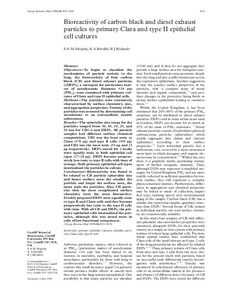Bioreactivity of carbon black and diesel exhaust particles to primary Clara and type II epithelial cell cultures
"Objectives:To begin to elucidate the mechanisms of particle toxicity to the lung, the bioreactivity of four carbon black (CB) and diesel exhaust particles ((DEPs), a surrogate for particulate matter of aerodynamic diameter <10 m (PM[10]), were examined with primary cultures of Clara and type II epithelial cells. Methods:The particles were extensively characterised by surface chemistry, size, and aggregation properties. Toxicity of the particles was assessed by determining cell attachment to an extracellular matrix substratum.Results:The spherulite size range for the particles ranged from 50, 40, 20, 20, and 30 nm for CB1-4 and DEPs. All particle samples had different surface chemical compositions. CB1 was the least toxic to Clara (170 g) and type II cells (150 g) and CB4 was the most toxic (55 g and 23 g respectively). DEPs stored for 2 weeks were equally toxic to both epithelial cell types (27-28 g). DEPs became progressively less toxic to type II cells with time of storage. Both primary epithelial cell types internalised the particles in culture.Conclusions:Bioreactivity was found to be related to CB particle spherulite size and hence surface area: the smaller the particle and larger the surface area, the more toxic the particles. Also, CB particles with the most complicated surface chemistry were the most bioreactive. Freshly prepared DEPs were equally toxic to type II and Clara cells and they became progressively less toxic to the type II cells with time. With all CB and DEPs, the primary epithelial cells internalised the particles, although this was noted most in cells of low functional competence."
Digital
The ETUI is co-funded by the European Union. Views and opinions expressed are however those of the author(s) only and do not necessarily reflect those of the European Union or the ETUI.
